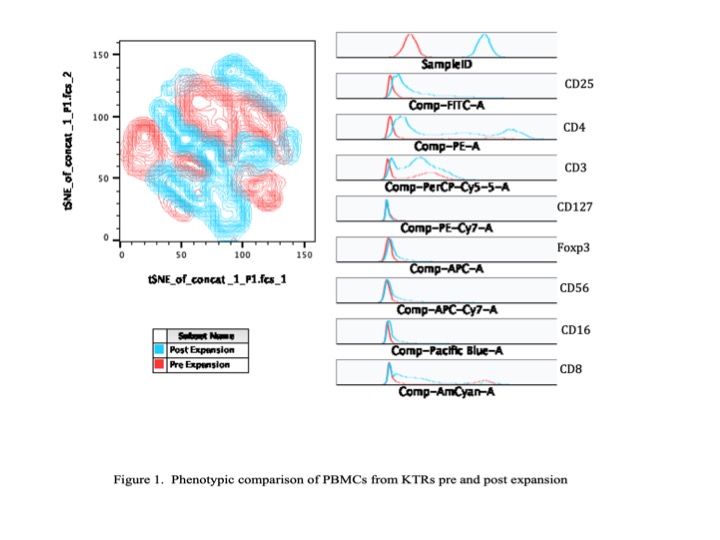Flow Cytometric Characterization of Regulatory Cell Populations Expanded Ex Vivo from PBMCs of Kidney Transplant Recipients
1Renal, Brigham and Women's Hospital, Boston, MA, 2Nephrology, Clinica Universidad de Navarra, Instituto de Investigación Sanitaria de Navarra (IdiSNA), Pamplona, Spain
Meeting: 2020 American Transplant Congress
Abstract number: D-378
Keywords: Allorecognition, Kidney transplantation, T cells
Session Information
Session Name: Poster Session D: Tolerance / Immune Deviation
Session Type: Poster Session
Date: Saturday, May 30, 2020
Session Time: 3:15pm-4:00pm
 Presentation Time: 3:30pm-4:00pm
Presentation Time: 3:30pm-4:00pm
Location: Virtual
*Purpose: We have previously shown that it is possible to generate alloantigen-specific regulatory T cell lines and clones that prolong allograft survival upon infusion in a rat model of allogeneic kidney transplant. The focus of the current study was to phenotypically characterize by flow cytometry similarly ex vivo expanded peripheral blood mononuclear cells (PBMC) from stable Kidney Transplant Recipients (KTRs).
*Methods: PBMC were isolated from stable KTRs and expanded ex vivo using donor antigen specific stimulation in presence of low dose IL-2 and phenotypic characterization was performed using a flow cytometer.
*Results: We were able to expand PBMCs from more than 20 KTRs using donor alloantigen specific stimulation in the presence of low dose IL-2. We then compared the populations pre and post expansion. Our results indicate that the populations post expansion were enriched in CD3+ CD4+ T cells in comparison to the pre expansion PBMCs. The T cell enriched post expansion populations showed increased expression of CD25 and Helios although no change in either Foxp3 or CD127 expression was observed. These T cells also expressed an array of regulatory markers associated with Tregs. These include increased expression of CTLA4, ICOS CD73, CD39, GITR, LAP, CD103 along with CCR7, CXCR3 and CCR6 post expansion. We also observed a small increase in both TIGIT and CD226 expression. There were minimal changes in GARP and PD-1 expression post expansion. IL-10 production increased post expansion whereas IFN-gamma showed no change. These cells were negative for CD45RA and positive for CD38 indicating a memory cell like phenotype. Similar to the rat studies the ex vivo expanded human cells demonstrated regulatory properties as determined by in vitro suppression assays. Apart from the CD3+ CD4+ T cells, the post expansion cell populations also showed an increase in CD3– CD56+ and CD11b+ cells with a decrease in CD3– CD16+, CD19+ cells and no change in the CD3+ CD8+ cell population.
*Conclusions: ex vivo expanded human cells demonstrated regulatory properties
To cite this abstract in AMA style:
Tripathi S, Martin-Moreno PL, Kavalam GJ, Chandraker A. Flow Cytometric Characterization of Regulatory Cell Populations Expanded Ex Vivo from PBMCs of Kidney Transplant Recipients [abstract]. Am J Transplant. 2020; 20 (suppl 3). https://atcmeetingabstracts.com/abstract/flow-cytometric-characterization-of-regulatory-cell-populations-expanded-ex-vivo-from-pbmcs-of-kidney-transplant-recipients/. Accessed December 22, 2025.« Back to 2020 American Transplant Congress

